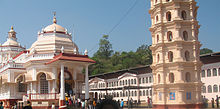- Culture of Goa
-
This article is about the culture of natives of the Indian state of Goa. A common generalisation about Goans is that they are born with music and football in their blood. This can be attributed to the fact that football and music are deeply entrenched in Goan culture.
Contents
Religion
Goa has a history of communal harmony.
Festivals
The most popular celebrations in the Indian state of Goa are Ganesh Chaturthi (Chavoth-Konkani), Diwali, Christmas (Natalam -Konkani), Easter (Paskanchem Fest -Konkani), Samvatsar Padvo or Sanvsar Padvo, Shigmo and the Carnival (Carnaval or Intruz -Konkani). Goa is also known for its New Year's celebrations. The Goan Carnival is known to attract a large number of tourists.
Education
Main article: Education in GoaCuisine
Rice with fish curry (Xit kodi in Konkani) is the staple diet in Goa. Goan cuisine is renowned for its rich variety of fish dishes cooked with elaborate recipes. Coconut and coconut oil is widely used in Goan cooking along with chili peppers, spices and vinegar giving the food a unique flavour. Pork dishes such as Vindaloo, Xacuti and Sorpotel are cooked for major occasions among the Catholics. An exotic Goan vegetable stew, known as Khatkhate, is a very popular dish during the celebrations of festivals, Hindu and Christian alike. Khatkhate contains at least five vegetables, fresh coconut, and special Goan spices that add to the aroma. A rich egg-based multi-layered sweet dish known as bebinca is a favourite at Christmas. The most popular alcoholic beverage in Goa is feni; Cashew feni is made from the fermentation of the fruit of the cashew tree, while coconut feni is made from the sap of toddy palms.
Architecture
Goa has two World Heritage Sites: the Bom Jesus Basilica [1] and a few designated convents. The Basilica holds the mortal remains of St. Francis Xavier, regarded by many Catholics as the patron saint of Goa (the patron of the Archdiocese of Goa is actually the Blessed Joseph Vaz). Once every twelve years, the body is taken down for veneration and for public viewing. The last such event was conducted in 2004. The Velhas Conquistas regions are also known for its Goa-Portuguese style architecture.
In many parts of Goa, mansions constructed in the Indo-Portuguese style architecture still stand, though in some villages, most of them are in a dilapidated condition. Fontainhas in Panaji has been declared a cultural quarter, showcasing the life, architecture and culture of Goa. Some influences from the Portuguese era are visible in some of Goa's temples, notably the Mangueshi Temple, although after 1961, many of these were demolished and reconstructed in the indigenous Indian style.
Sports
Football is the most popular sport in Goa, followed by hockey. Cricket, athletics, chess, swimming, table tennis and basketball are other popular sports in Goa. Fishing is also a popular recreational activity.
Science
See also: Goans in science and technologyArts
Music
Mando and dulpod are traditional goan musical forms.
Goan Hindus are very fond of Natak, Bhajan and Kirtan. Many famous Indian Classical singers hail from Goa, such as , Kishori Amonkar, Kesarbai Kerkar, Jitendra Abhisheki, Prabhakar Karekar.
Many Goans also perform Western classical music
Dance
Some traditional Goan dance forms are dekhnni, fugdi, and corridinho. Western social dancing is a part of most celebrations.
Theatre
Tiatr is the major Goan form of theatre.
Cinema
See also: Konkani cinemaLiterature
Tourism
Goa developed an international reputation in the 1960s as one of the prime stops on the legendary India-Nepal "hippie" trail. In the mid-1960s, several Westerners, including "Eight Finger Eddie" walked over the hill to Calangute, and decided to create a community for Westerners. In the early years, Calangute and Baga were the center of this scene, but it grew over the years to include other nearby cities like Anjuna Beach, which became, and arguably still is, the epicenter of the Western youth culture of Goa. By the mid-1980s, there were over 8000 Westerners living in Goa, mostly from Western Europe. The scene was marked by drug culture, trance music and free love. Goa remains today an international epicenter of youth culture.
Starting in the late 1990s, Goa began to attract a more "upscale" audience, which in turn drove prices up, which in turn drove many in the "hippie" community to other less-expensive areas. Arambol—the beach community furthest away from "civilization", like electricity and running water—became the center of a battle between those wanting to turn Goa into a more traditional upscale resort area, and those wanting Goa to retain its traditional rustic counterculture appeal.
See also
- Goans in Hindi film music composition
References
External links
Goa History Government Chief Ministers · Legislative Assembly · Raj Bhavan · State seal · Political parties · Goa Police · Goa civil codeGeography Districts Talukas Cities Heritage sites Wildlife sanctuaries Education Science Goans in science · National Institute of Oceanography · National Centre for Antarctic and Ocean ResearchCulture Comunidades · Cuisine · Goans · Konkani cinema · Konkani language · Literature · Media · Music · Shigmo · Goans in sports · TiatrSports TeamsGoa football team · Goa cricket team · Churchill Brothers SC · Dempo SC · Salgaocar SC · Sesa Football Academy · Sporting Clube de Goa · Vasco SCStadiaCompetitionsGoa Professional LeagueTransport Portal • Category • Wikiproject Categories:
Wikimedia Foundation. 2010.

